Meet the all-female patrol guarding Ecuador's Amazon Rainforest
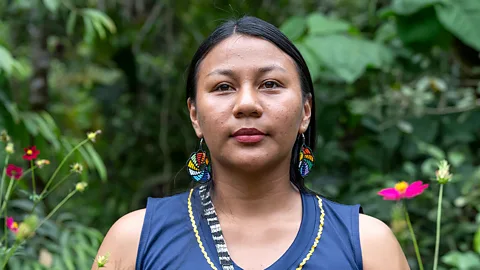 Ana Maria Buitron
Ana Maria BuitronThe Yuturi Warmi, an Ecuadorian patrol group, has vowed to protect their community's land in the Amazon Rainforest from the pollution of extractive industries – and their efforts appear to be working.
It is the break of dawn in the Serena community, in the middle of the Ecuadorian Amazon. Along the Jatunyacu River, which later joins the Amazon River in the Napo Province, Elsa Cerda, a 43-year-old indigenous Kichwa woman, brews guayusa leaves – a native plant from the rainforest – in a pot.
It marks the start of the Guayusa Upina, a ritual performed by Amazonian indigenous peoples before beginning their daily activities. This tradition is more than a routine; it's a spiritual connection to their ancestral roots.
As the first rays of light begin to filter through the tree canopy, a diverse assembly of 35 women, ranging from 23 to 85 years old, arrives one by one at the ceremony. The eldest among them, Corina Andy, who is fondly called "abuela", "the grandmother", leads them in a collective cleansing ritual using medicinal plants.
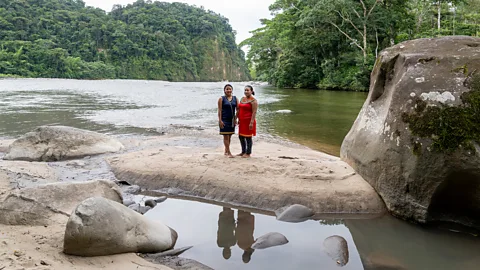 Ana Maria Buitron
Ana Maria BuitronMeanwhile, the younger women chant and dance to traditional songs in their native language, Kichwa Napo.
"Strength, strength!" Cerda shouts, and as the echo lingers, the women respond with "guard, guard!".
The 'strong ants'
The group goes by the name of "Yuturi Warmi". Elsie Alvarado, one of the youngest members of the Yuturi Warmi, explains that in the Kichwa language "Yuturi" references a type of ant in the Amazon known for its strong and defensive nature, and "Warmi" means woman.
"We chose this name for the group because it symbolises our fight and strength, much like the ants that resist and protect their territory," she says.
The Yuturi Warmi steadfastly monitor the threat of mining activities on their community of 154 members by patrolling a large area of land, which the women estimate is between three sq miles (7.8 sq km) and 3.9 sq miles (10 sq km). Despite there being metal contamination reported up and downstream, the women say their patch of land – and river – has remained pristine.
"The waters of Serena remain pure, allowing us to fish native species like catachamas and bocachicas that thrive in these untainted waters," says Andy.
Nestled an hour's drive from Tena, the capital of the Napo province, the Serena community stands among the 50 indigenous communities along the Jatunyacu River. Their role as Amazonian guardians involves safeguarding the territory from pollution and preserving the land and rivers from activities that jeopardise biodiversity – such as deforestation and mining operations.
Andrea Sempértegui, a researcher and assistant professor of politics at Whitman College in Washington, highlights the "longstanding but often invisible fight of indigenous women in the extractive industry". Groups such as Yuturi Warmi are "bringing this struggle to the forefront and gaining much-needed recognition".
The women of Yuturi Warmi's position is to "stand on the frontlines, embodying the resilience, determination, and strength of indigenous women in the Amazon", says Cerda, who acts as the group's leader.
The catalyst for Yuturi Warmi's formation traces back to 2020, when 35 Serena women, including farmers, homemakers, artisans and students, united to protect their land and river.
The women began to gather weekly for community updates, sharing best monitoring practices, findings, concerns – and solutions – and they still continue their weekly meetings.
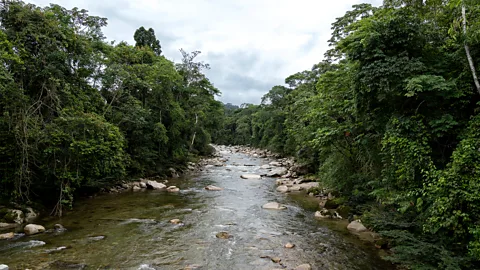 Ana Maria Buitron
Ana Maria Buitron"We felt it was a collective responsibility to safeguard our crystal-clear rivers – an ancestral gift spanning generations," says Rosaura Alvarado, a single mother.
"For us indigenous peoples, nature is interconnected with us; we are one, and destroying nature means harming ourselves," she says. This belief motivated her to take action to monitor the community's land, she says.
At first, the group faced backlash from the men in their community. Cerda's husband was initially sceptical. However, she says his perspective has changed, and "he is now supportive".
Mining the Amazon
As threats to the Amazon – an expansive region spanning nine South American countries and encompassing 2.5 million sq miles (6.5 million sq km) – continue to mount, the presence of indigenous guards is becoming increasingly important. And female indigenous groups like the Yuturi Warmi, and the Xikrin women in Brazil, are becoming more prominent.
While women are involved in other indigenous guard groups in the Amazon region, Yuturi Warmi is the only one solely composed of and led by women, says Sempértegui.
Ecuador's Amazon, situated in the eastern expanse of the country, has a long history with extractive industries. Deforestation, oil exploitation and mining activities, particularly in the Napo province, have etched an indelible mark on this richly biodiverse region.
Climate Guardians
This article in the Climate Guardians series was supported by funding from the European Journalism Centre, through the Solutions Journalism Accelerator. This fund is supported by the Bill & Melinda Gates Foundation.
Satellite imagery captured in October 2023 showed that between 2015 and 2021, mining activities in the Ecuadorian Amazon increased by 21.7 sq miles (56 sq km). Napo province saw the biggest increase – 4.3 sq miles (11 sq km) had new mining activity during that time frame – an increase of 316%, according to the non-profits Monitoring of the Andean Amazon Project and the Ecociencia Foundation. The organisations reported that 17% of this increase was beyond legally designated mining zones.
This substantial uptick in mining activities finds its roots in economic challenges, according to representatives from the Napo Resiste, a collective of indigenous and non-indigenous members from the Napo region who campaign for environmental and human rights. More than half of the population in Ecuador's Amazon lives in poverty. Mining provides a source of much-needed income in an area with few basic state services, the group says.
In 2019, the Ecuadorian government was found to have disregarded the Ecuadorian Waorani people's indigenous right to free, prior and informed consultation when it put a large tract of Amazon rainforest up for sale for oil concessions. The right is acknowledged in the national constitution and international agreements. Ecuadorians have been pushing back against oil drilling; 60% of the country's population voted in 2023 to end oil drilling in Yasuní National Park. But elsewhere in the country, oil extraction continues.
 Ana Maria Buitron
Ana Maria BuitronIn the province of Napo, the government has granted 153 legal mining concessions covering 323 sq km (125 sq miles) since 2007.
Both legal and illegal mining in the Ecuadorian Amazon have impacts on the environment and human wellbeing. A 2022 study by scientists from universities in Spain, Mexico and Ecuador identified high concentrations of toxic metals in the upper Napo River basin. The study drew a direct link between gold mining and the presence of metals in the upper Napo River basin, which cause "severe environmental pollution", as well as increasing exposure risks to surrounding communities. The researchers found an increase in cancer risks and death by poisoning for adults and children who lived near sites polluted by mining. "The study suggests chronic toxicological risks in all sites evaluated and potential carcinogenic risks in most of the sites," the scientists wrote.
In another study in 2021, the researchers collected water samples in the upper basin of the Napo River, near the Jatunyacu River, and found that 63% of the monitored water bodies had poor water quality due to high concentrations of metals caused by gold mining. The poor water quality posed a risk to the health of the Amazonian communities, the study found, and also impacted fish populations in the region.
Rodrigo Espinosa, an Ecuadorian aquatic ecology professor at the Universidad Regional Amazónica Ikiam in Tena, Ecuador, was an author of the 2021 study. "Rivers that were once crystal clear now turn murky," he says. "When we go out for our research, just by observing the colour of a river, we can tell that there's mining in the area."
Espinosa warns about the repercussions this can have on human health. "The immediate effects we see are more at the skin level, like peeling," he says. "However, these metals, when released into the atmosphere, produce chemicals that, even when inhaled through the nose, can be carcinogenic."
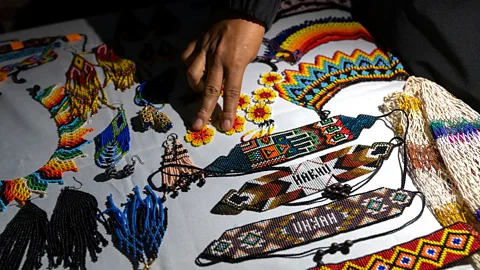 Ana Maria Buitron
Ana Maria BuitronOn patrol
The Yuturi Warmi monitor the region once a month, planning meticulously what ground they will cover. Led by Cerda, they venture along the riverbanks and deep into the surrounding forests, equipped with camera traps and drones that have been bought thanks to community donations and proceeds from selling artisanal crafts.
During their patrols, which typically span two to three days, the women keep a vigilant eye out for any signs of mining encroachment or environmental degradation.
When on patrol, they document their findings, capturing photographic and video evidence that is catalogued and analysed upon their return. This data serves as a critical tool in their advocacy efforts and raising awareness among local and international communities through social media.
The women undergo regular training sessions, with younger women teaching older members how to operate these phone cameras and drones. Each patrol involves a rotation of members, particularly the younger ones, who primarily patrol the land, ensuring continued presence and surveillance. The women do not carry any weapons, relying instead on their collective presence to act as a deterrent.
In the event of witnessing illegal mining activities, the women prioritise non-violent measures such as contacting the authorities and gathering evidence.
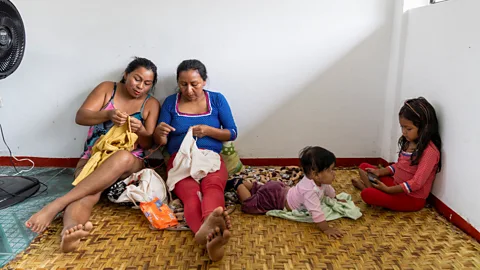 Ana Maria Buitron
Ana Maria BuitronIn addition to protecting their land in person, the Yuturi Warmi have also taken their fight to court.
One case was known as the "Manati Operation", which took place in February 2022. It was a collaborative effort between the Serena women, the advocacy group Federation of Indigenous Organisations of Napo and the Ombudsman's Office, which is responsible for addressing citizens' complaints of potential human rights violations by state or private authorities.
This movement aimed to expose the environmental damage in the Yutzupino community of Napo, which neighbours the Serena. Between October 2021 and February 2022, the collaboration found more than 700 unlicensed miners engaged in gold extraction activities in a 103-hectare (256 acre) area.
The operation resulted in the confiscation of 107 excavators used in illegal mining, which had been causing damage to about 0.2 sq miles (0.42 sq km) of the main water basins of the Jatunyacu River. On 13 April, 2022, the provincial court issued a ruling regarding the violation of nature's rights; the ruling stipulates that the Ministry of Environment is accountable for formulating a plan to repair and reforest the affected area.
Despite the court's ruling, challenges remain, says Espinosa. Authorities have failed to implement directives, such as a plan to reforest the damaged areas, and the environmental damage persists.
Even though the community is eager to engage in reforestation efforts, Espinosa continues, it's challenging without a formal, cohesive plan by a larger multinational organisation. He says that as the area of the Jatunyacu River affected by mining flows into the Napo and ultimately into the Amazon, the damage "impacts the entire region".
Members of Yuturi Warmi believe that the government is unlikely to take effective action, prompting them to rely on their community organisation for protection and support. They firmly assert that "real progress can only happen through their collective efforts".
The government did not respond to the BBC's request for comment by the time of publication.
Pioneering leadership
The women say their pioneering work differs from other male guard groups, who primarily focus on land patrolling. They emphasise the preservation of their language and culture while also turning to activities such as sewing and artisanal jewellery. This is vital in staving off mining, says Sempértegui – these artisanal activities provide an alternative source of income for the community.
"[It's] a pioneering model of female indigenous leadership that could inspire other communities," says Sempértegui.
The impact of the Yuturi Warmi and other Amazonian women leaders extends beyond environmentalism, she says. "They actively advocate for an environmental policy rooted in the jungle, one that embraces cultural, identity, and environmental preservation. Their vision seeks to integrate a holistic perspective, shaping a sustainable future that honours both the land and its people."
More like this:
Paola Cerda, a young mother, says there is an empowering atmosphere within the group.
"I am here to share, laugh, learn, and generate resources that have helped me regain my independence," she says. "Our current goal is to extend this transformative model to other communities, providing support to more indigenous women and their families."
The Yuturi Warmi firmly argue that the destiny of the Amazon has global significance. A thriving Amazon translates to a flourishing planet.
--
For essential climate news and hopeful developments to your inbox, sign up to the Future Earth newsletter, while The Essential List delivers a handpicked selection of features and insights.
